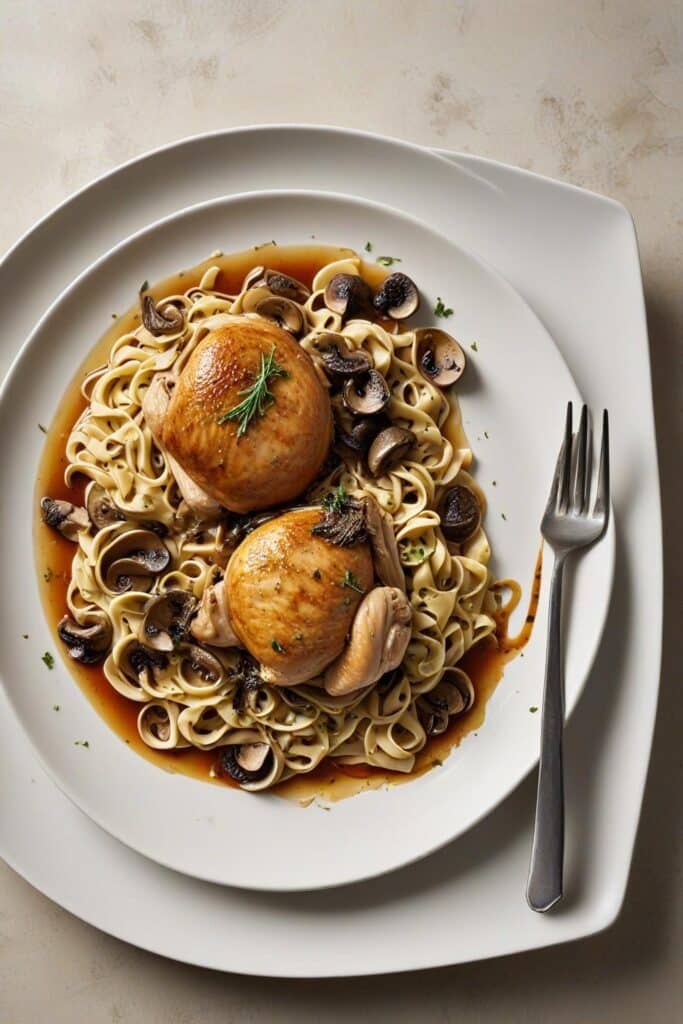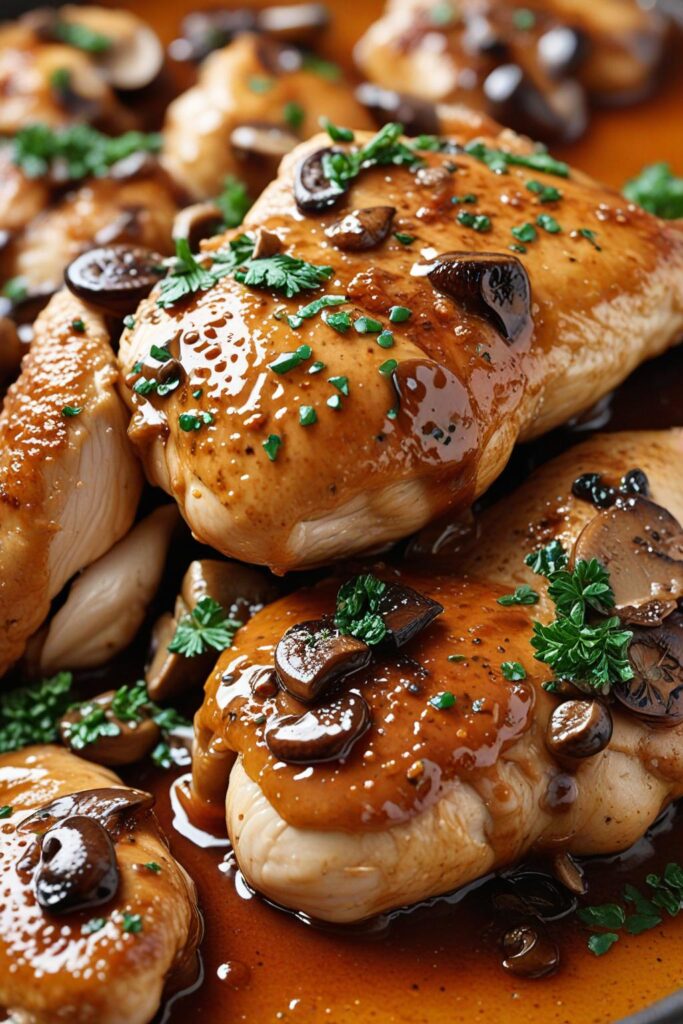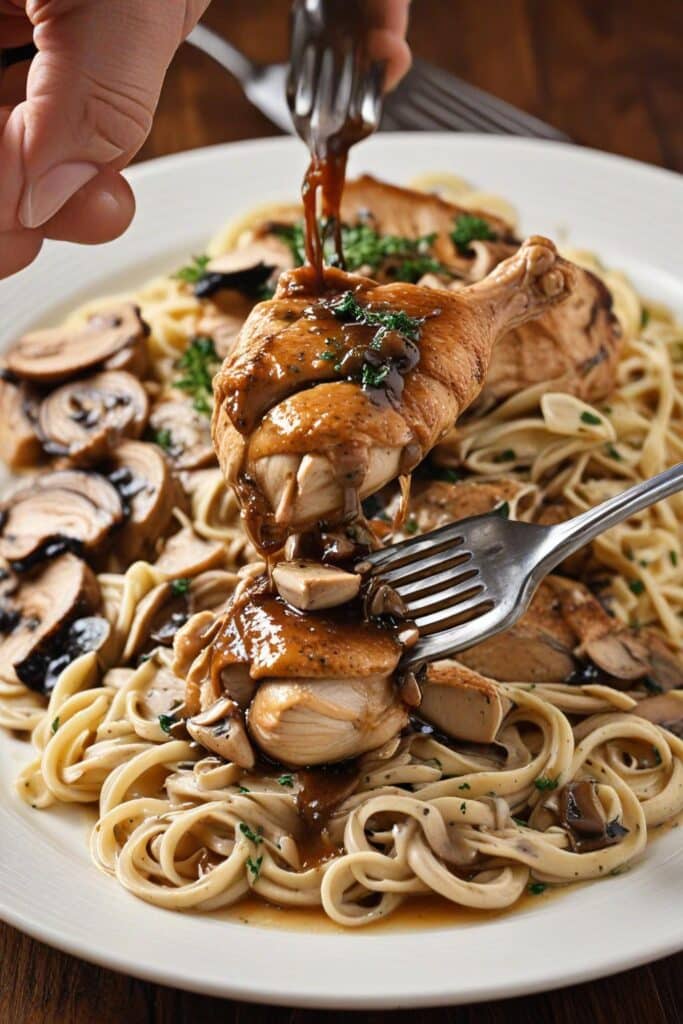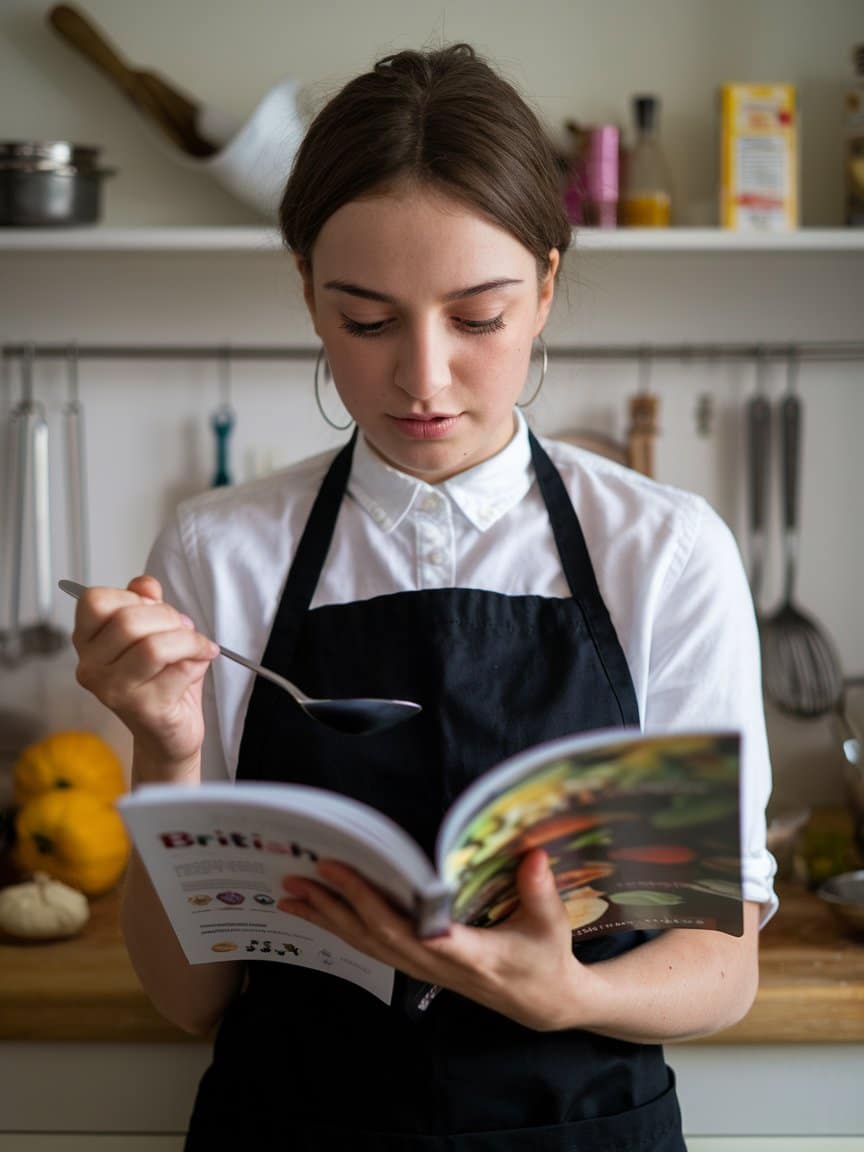I still remember the first time I tasted a properly executed Chicken Marsala. It was at my Italian grandfather’s table, where he’d prepare this dish with a reverence that bordered on religious. The mushrooms had caramelized edges, the chicken was tender yet substantial, and that sauce—oh, that sauce—had a complexity that belied its relatively simple ingredient list. Years later, as a professional chef, I’ve prepared this dish thousands of times, yet it’s never lost its magic.
Chicken Marsala with buttered noodles represents Italian-American cuisine at its finest—a harmonious marriage of Old World techniques with New World accessibility. It’s deceptivly simple, yet it harbors depths that reward the attentive cook who understands its subtleties.
The Soul of the Dish: Ingredients & Substitutions
For the Chicken Marsala:
- 4 boneless, skinless chicken breasts (about 6-8 oz each), pounded to ¼-inch thickness
- Kosher salt and freshly ground black pepper
- ¾ cup all-purpose flour, for dredging
- 3 Tbsp extra-virgin olive oil
- 4 Tbsp unsalted butter, divided
- 12 oz cremini mushrooms, sliced ¼-inch thick
- 2 large shallots, finely diced (about ½ cup)
- 2 garlic cloves, minced
- 1 Tbsp fresh thyme leaves
- 1 cup dry Marsala wine
- ¾ cup low-sodium chicken stock
- 2 Tbsp heavy cream (optional)
- 2 Tbsp chopped fresh Italian parsley
For the Buttered Noodles:
- 12 oz egg noodles
- 4 Tbsp unsalted butter
- 2 Tbsp chopped fresh parsley
- Salt and freshly ground black pepper
The beauty of this dish lies in its flexibility. Don’t have cremini mushrooms? Shiitakes or even regular white button mushrooms werk just fine—though I prefer cremini for their earthy undertones. The chicken breasts can be swapped for thighs if you prefer a juicier, more forgiving protein.
For those avoiding alcohol, you might be tempted to skip the Marsala entirely, but that would fundamentally change the dish. Instead, try a non-alcoholic substitute: mix ¾ cup of white grape juice with 2 Tbsp of balsamic vinegar and a pinch of nutmeg. It won’t be identical, but it’ll capture some of that sweet-acidic balance that makes Marsala so distincitve.
If you’re gluten-sensitive, the flour dredge can be replaced with rice flour or a gluten-free all-purpose blend. The resulting crust might be slightly different in texture, but the difference is negligible, especially once the chicken is bathed in that glorious sauce.
Mastering the Method: Step-by-Step Instructions
Preparing the Chicken
- Place the chicken breasts between two sheets of plastic wrap and pound to an even ¼-inch thickness. Season both sides generously with salt and pepper.
- Place flour in a shallow dish and dredge each chicken breast, shaking off excess. This thin coating is crucial—you want just enough to create a subtle crust that will help thicken the sauce later, but not so much that it becomes gummy or dominates the dish.
- Heat 2 tablespoons of olive oil in a large skillet over medium-high heat. When the oil shimmers—but before it smokes—add the chicken breasts in a single layer, being careful not to overcrowd the pan.
Working in batches is often necessary here. There’s an old culinary saying: “A crowded pan is a cold pan.” Give each piece of chicken enough space to properly brown rather than steam. You’re looking for a golden crust that’ll provide both visual appeal and flavor through the Maillard reaction.
Creating the Sauce
- After cooking all chicken pieces (about 3 minutes per side), transfer them to a plate and tent loosely with foil. They’ll finish cooking in the sauce later, so don’t worry if they’re slightly underdone.
- Without cleaning the pan (those brown bits are flavor gold!), add 2 tablespoons of butter and the remaining olive oil. When butter is melted, add mushrooms in a single layer and don’t touch them for at least 2 minutes. This counter-intuitive patience is what develops their deep, meaty flavors.
The biggest mistake home cooks make with mushrooms is moving them too much. Let them develop those gorgeous browned edges. They’ll release moisture initially, which might make you nervous, but keep going—once that moisture evaporates, they’ll begin to caramelize.
- When mushrooms have browned (about 5 minutes total), add shallots, garlic, and thyme. Cook until fragrant, about 1 minute. The garlic should become aromatic but not brown, which would introduce bitterness.
- Add the Marsala wine, using a wooden spoon to scrape up the fond (those flavorful browned bits) from the bottom of the pan. Bring to a simmer and reduce by half, about 3-4 minutes.
The reduction of the Marsala is where the magic happens. You’re concentrating flavors while cooking off the harsh alcohol notes, leaving behind a sweet, complex base. Don’t rush this step—proper reduction is what separates mediocre Marsala from magnificent Marsala.
- Add chicken stock and simmer for another 2-3 minutes to meld the flavors. If using heavy cream, stir it in now for a silkier, richer sauce.
- Return the chicken to the pan, including any accumulated juices (more flavor!). Simmer gently until chicken is cooked through and sauce has slightly thickened, about 3-4 minutes.
- Swirl in remaining 2 tablespoons butter off heat, which creates a glossy finish to the sauce through the process of monte au beurre. Sprinkle with parsley just before serving.
For the Buttered Noodles
- While preparing the chicken, bring a large pot of heavly salted water to a boil. The water should taste like the sea—this is your only chance to season the pasta itself.
- Cook egg noodles according to package directions until al dente, typically 6-8 minutes.
- Drain noodles, reserving ½ cup of pasta water. Return noodles to pot, add butter, and toss until noodles are evenly coated. If noodles seem dry, add a splash of reserved pasta water—the starch in this water helps create a silky sauce.
- Fold in parsley, season with salt and pepper to taste, and serve immediately with the chicken Marsala spooned overtop.
The Science & Artistry Behind the Dish
Chicken Marsala exemplifies several fundamental cooking techniques working in perfect harmony. The dredging and sautéing of the chicken creates a protective coating that seals in moisture while developing flavor through the Maillard reaction—a complex series of chemical interactions between amino acids and reducing sugars that creates hundreds of new flavor compounds.

The deglazing process with Marsala wine does more than add flavor; it dissolves those caramelized proteins stuck to the pan (the fond) through both alcohol’s solvent properties and the process of hydration. Marsala isn’t just any wine—it’s a fortified wine with a higher alcohol content and a distinctive nutty, slightly sweet profile resulting from its unique oxidative aging process.
This oxidation is key to Marsala’s complexity, as it creates compounds called aldehydes and acetals that contribute to its characteristic flavor profile. These compounds readily bind with the glutamates in the mushrooms, amplifying the umami characteristics of the dish.
Meanwhile, your buttered noodles provide more than just a vehicle for the sauce. The high starch content of egg noodles means they’ll grab onto the butter coating more effectively than other pasta varieties might. The alkalinity of the eggs in the pasta dough also contributes to their distinctive tender-yet-toothsome texture.
Serving & Presentation Strategies
For a restaurant-quality presentation, consider arranging the buttered noodles in a nest formation in the center of a wide, shallow bowl or plate. Place the chicken slightly overlapping on top, then spoon the mushroom sauce generously over the chicken, allowing it to cascade down onto the noodles.

A small garnish of fresh thyme leaves or a light dusting of finely grated Parmigiano-Reggiano adds visual interest without competing with the star flavors of the dish.
When it comes to pairings, Chicken Marsala’s complex flavors work beautifully alongside:
- A simple arugula salad dressed with lemon juice and olive oil to cut through the richness
- Roasted asparagus or broccolini for a vibrant green element
- Crusty Italian bread for sopping up every last drop of that precious sauce
Wine pairing should complement rather than compete with the Marsala in the dish. A medium-bodied Pinot Noir or a crisp Pinot Grigio both work well, depending on whether you prefer red or white. For a perfect symmetry, serve the same Marsala you cooked with as an aperitif.
Beyond the Basics: Variations & Innovations
Once you’ve mastered the classic version, consider these professional variations:

Porcini Marsala: Reconstitute 1 oz dried porcini mushrooms in hot water for 30 minutes. Strain (reserving the soaking liquid), chop, and add to the fresh mushrooms. Replace part of the chicken stock with the strained porcini soaking liquid for an intensified earthy dimension.
Prosciutto Marsala: After sautéing the mushrooms but before adding the Marsala, add 3 oz of thinly sliced prosciutto cut into strips. The saltiness creates a delicious counterpoint to the sweet wine.
Wild Mushroom Medley: Replace half the cremini mushrooms with a mixture of oyster, shiitake, or maitake mushrooms for a more complex flavor profile and textural contrast.
Marsala Sous Vide: For the ultimate tender chicken, sous vide the chicken breasts at 145°F (63°C) for 1 hour before quickly searing and proceeding with the sauce as directed. This technique provides unparalleled juiciness.
Conclusion:
Mastering the Marsala Moment
A truly great Chicken Marsala with buttered noodles transcends its humble ingredients to become greater than the sum of its parts. It’s a dish that rewards attention to detail, from properly reducing the wine to developing deep mushroom flavors to finding that perfect balance of richness and acidity.
What makes this dish spescial isn’t exotic ingredients or complicated techniques—it’s understanding the why behind each step, having the patience to let flavors develop, and respecting the balance that makes this Italian-American classic endure despite changing culinary fashions.
Whether you’re cooking for family on a Tuesday night or attempting to impress dinner guests, mastering this dish gives you a reliable yet impressive arrow in your culinary quiver. And unlike many restaurant favorites, a home-cooked Chicken Marsala can easily surpass restaurant versions, especially when made with care and served fresh from the skillet onto warmed plates.
Frequently Asked Questions?
Why does my sauce break or look greasy?
The most common culprit is heat that’s too high when adding the butter at the end. Make sure to take the pan off the heat before swirling in the final butter. If your sauce does break, a quick fix is to add a tablespoon of heavy cream and whisk vigorously off heat.
Can I make Chicken Marsala ahead of time?
You can prepare the components up to a day ahead, but for best results, I recommend cooking the chicken about 75% of the way through, then refrigerating it separately from the sauce. When ready to serve, gently reheat the sauce, add the chicken to finish cooking, and prepare fresh buttered noodles.
What’s the difference between dry and sweet Marsala, and which should I use?
Dry Marsala (secco) has less residual sugar and works better for savory dishes like this one. Sweet Marsala (dolce) is traditionally used for desserts. In a pinch, you can use sweet Marsala for this dish, but reduce any added stock to account for the additional sweetness.
My mushrooms release too much liquid and never brown properly. What am I doing wrong?
Two likely issues: your pan may not be hot enough, or you’re overcrowding the mushrooms. Work in batches if necessary, and resist the urge to stir them constantly. Also, avoid washing mushrooms right before cooking—instead, clean them with a damp paper towel to remove any dirt.
Can I substitute chicken thighs for breasts?
Absolutely! Boneless, skinless chicken thighs make an excellent substitute. They’re more forgiving if slightly overcooked and offer richer flavor. Pound them as you would the breasts, though they won’t need to be quite as thin since thighs are naturally more tender.

Veronica is a passionate food enthusiast with over three years of experience in exploring and writing about diverse cuisines. Her expertise lies in reviewing restaurants, sharing creative recipes, and discovering the latest food trends. As the voice behind FoodieRecap.com, Anju brings fresh perspectives and culinary insights to her audience.
